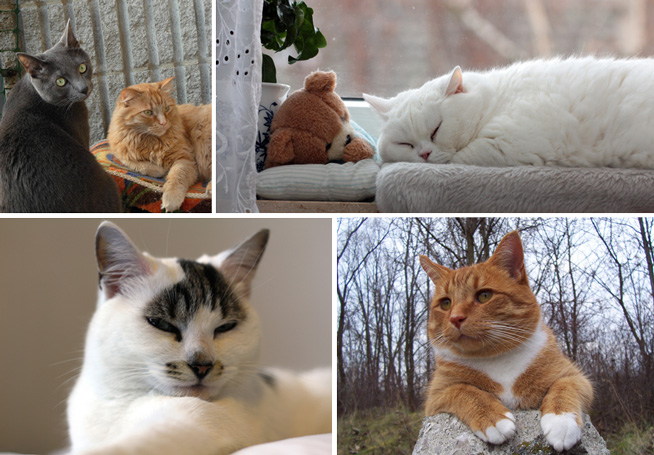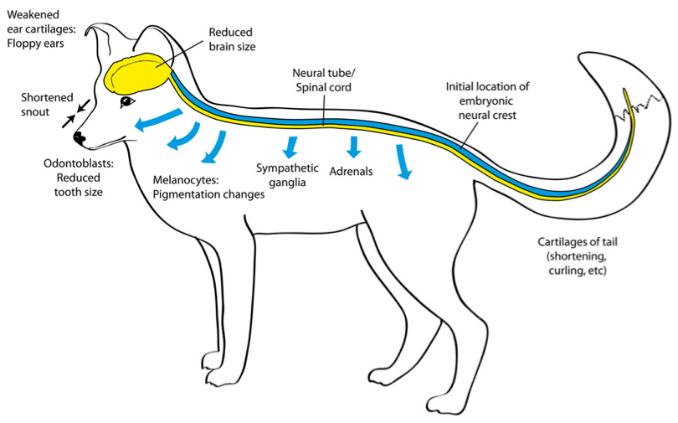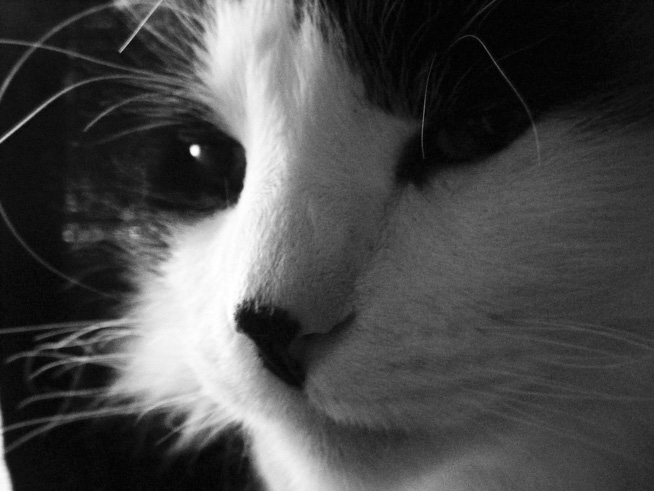Mammal domestication is a hot topic, with many groups releasing detailed genetic studies of different models of domestication. This week we’ll look at the genetics of cat colors and follow up on the recently published domestication syndrome hypothesis. Next week we’ll feature new research on experimental rat domestication. Stay tuned!
Does your cat have a white belly? Or maybe white “socks” or other patches of white on its flanks or face? Or is it entirely white except for a few patches of color? Then, unless it happens to be a Birman, it probably descends from one particular cat. We don’t know exactly when this cat lived, but we do know that a fragment of DNA leftover from ancestral retroviral infections inserted itself into a new location in the cat’s genome.
Research by David, Menotti-Raymond, and Coots Wallace et al. in the October G3 shows that the common coat pattern that geneticists call “white spotted” (though “white patched” would be more accurate) is caused by insertion of an endogenous retroviral element into a gene involved in pigment cell migration. Remarkably, a single insertion event is responsible for both white spotting and all-white coloration in most types of cats.

Macadam and Chiffon (top left) are fully pigmented (Image credit: Lucie Provencher,CC BY-SA 2.0); Lucky (top right) is all white (Image credit:Mel CC BY-ND 2.0); Queen Toffee (bottom left) is white spotted (Image credit: Chris Isherwood CC BY-SA 2.0); and Sonny (bottom right) is also white spotted (Image credit: Tina :0) CC BY-NC-ND 2.0)
Nearly a century ago, geneticist Phineas Whiting lived up to his name by proposing that white coats and white spotting are controlled by different alleles at a single locus, W. In his model, completely white cats carry a W allele that is dominant to two alleles for white spotting, which are in turn dominant to the wild-type (all-over color) allele. Later studies have shown Whiting was mostly correct. The presence of all-white or white patchy fur can be largely explained by alleles at a single gene. The same alleles are also responsible for the association of white coats with deafness.
For some years, geneticists have suspected that the W locus is located at the gene KIT, which encodes the mast/stem cell growth factor tyrosine kinase receptor. KIT is involved in the migration, proliferation, and survival of melanoblasts, the precursors of pigment cells. During embryonic development, melanoblasts migrate from the neural crest (which lies alongside the developing spinal cord) out along the flanks, limbs, tail, and head of the animal. KIT mutations in mice severely impair the survival of melanoblasts during this migration, and cause a white spotted pattern.
The authors of this new study in cats set out to confirm the identity of the W locus and find the specific alleles involved in white coats and feline deafness. In two large pedigrees of cats bred at Johns Hopkins University, the team tracked coat color and hearing ability and compared these traits to the KIT gene sequence.

A cat family segregating for the white spotting trait. W+ = wild-type KIT allele; WS = white spotted allele/full length FERV element in KIT. From David, Menotti-Raymond, and Coots Wallace et al.
They found that white spotted cats carried an insertion of a full-length feline endogenous retrovirus (FERV-1) within a highly conserved regulatory region in the first intron of KIT. The completely white cats carried a much reduced version of the same FERV-1 insertion, including only a single long terminal repeat (LTR) from the original retroviral sequence. Presumably recombination between the two LTRs of the full-length version resulted in deletion of most of the intervening sequence. This LTR-only allele was also clearly associated with deafness. The fact that both the white (LTR-only) and the white spotted (full length FERV) alleles are derived from the same insertion event suggests it happened recently in cat evolution.
But was this event also responsible for white patches in other cats? Were these alleles common or were they just flukes of one particular cat family? To find out, the authors tested KIT genotypes in 270 cats of 30 different breeds, running the gamut from Maine Coon Cat to Egyptian Mau. Every pure white cat in the survey was found to carry at least one LTR-only allele, and all but one of the white spotted cats carried a full-length FERV-1 insertion.
The clear link between FERV-1 insertion and white spotting was confirmed as part of a paper published this week, reporting the new cat reference genome. The work also revealed a new KIT allele responsible for the cute white paws of Birman cats. Nearly 100 years since Dr. Whiting inferred the existence of these alleles from test crosses, we now know their identity and sequence and can begin to tease out their functional and evolutionary consequences.
Looking more broadly at genes associated with cat domestication, the authors of the cat genome study also found tentative support for the neural crest domestication syndrome hypothesis recently published in a Perspective article in the journal GENETICS. The hypothesis, proposed by Perspectives editor Adam Wilkins (Humboldt University), Richard Wrangham (Harvard University) and Tecumseh Fitch (University of Vienna), seeks to explain why domesticated mammals all share a suite of traits that includes tameness, short faces, floppy ears, and patches of white fur. Wilkins et al. pointed out that nearly all the traits of “domestication syndrome” could be affected by mild deficits of neural crest development. In their proposal, strong selection for docility could result in changes in the way the adrenal glands and sympathetic nervous system develop from the neural crest, and side-effects of these deficits could include changes in face shape, ear cartilage formation, and pigmentation.

Developmental schematic. The blue tube indicates the approximate position of the neural crest in the early embryo, and the blue arrows indicate pathways of neural crest cell migration. From Wilkins et al.
In the new cat study, the authors looked for the genetic footprints of domestication by finding genetic regions that showed signatures of selection in domestic cats but not their wild relatives. As predicted by the domestication syndrome hypothesis, several of the identified genes affect the migration and development of the neural crest, though more work is needed to fully test the idea.
Could the neural crest hypothesis also explain why the white spotting alleles of KIT are so common among cats? KIT mutations affect the migration of a neural-crest derived cell population, but these mutations are not known to also affect behavior. Unless it has pleiotropic effects on both pigmentation and tameness, this gene may not be a major contributor to domestication syndrome. A simpler explanation for why the white spotting alleles of KIT have been so successful is that they generate cats that are pretty. And, as any quick survey of the internet will reveal, humans are inordinately fond of pretty cats.
David V.A., M. Menotti-Raymond, A. C. Wallace, M. Roelke, J. Kehler, R. Leighty, E. Eizirik, S. S. Hannah, G. Nelson, A. A. Schaffer, C. J. Connelly, S.J. O’Brien, & D.K. Ryugo (2014). Endogenous Retrovirus Insertion in the KIT Oncogene Determines White and White spotting in Domestic Cats, G3, 4 (10) 1881-1891. http://www.g3journal.org/content/4/10/1881.full DOI: 10.1534/g3.114.013425














